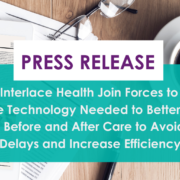COVID-19 & Cyber-Attacks: Being Prepared for Downtime when there is no Down Time
Another healthcare crisis making headlines, one that cannot be controlled with social distancing or even a vaccine, is cyber-attacks.
A recent article in The New York Times unravels how a wave of damaging attacks on hospitals upended the lives of patients with cancer and other ailments. This latest wave of cyber threats against the U.S. healthcare system is part of a growing trend. With COVID-19 infections and hospitalizations climbing nationwide, experts say healthcare providers are dangerously vulnerable to more cyber-attacks.
The pandemic has certainly generated a wave of new technologies that are completely changing the practice of modern medicine. Telehealth, virtual check-ins, and electronic forms completion from home are becoming the norm – and most patients and staff have embraced these changes with open arms. But this sudden move to virtual care, does not come without challenges. In fact, it has created, in many cases, a ‘perfect storm’ for cybercriminals.
These rapid technological advances have punched holes in tried-and-true security perimeters and have created more entry points for hackers to target. Quickly pushing more patient information to the cloud has opened doors to new vulnerabilities to cyber-attacks that have had yet to be considered. As a result, many health systems have found themselves in a desperate and unexpected downtime situation.
According to a recent blog from CereCore, when it comes to downtime, it’s not a matter of if, but when. The blog summarizes through various industry experts that healthcare organizations must be well prepared in advance of an incident occurring. Hospitals should continue to function effectively when reverting to manual procedures during unplanned downtime or network disruption.
It is no surprise that downtime events in healthcare organizations can directly impact patient safety, revenue, staff productivity, and the patient experience. In fact, HIPAA regulations require organizations to “establish procedures to enable the continuation of critical business processes…while operating in emergency mode.” Yet, 43% of downtime procedures not being followed or not in place (JAMIA study).
Unplanned downtime can be a shock to your hospital’s system, as well as its finances. With each added minute, an idle EHR can dramatically impair the functionality of your hospital and, on average, cost an incredible $8,662 per minute.
The silver lining? There are solutions healthcare systems can put in place to be prepared to continue to operate efficiently during downtime.
Whether it be due to cyberattacks, scheduled system updates, EHR outages, or even a tornado, Interlace Health’s Downtime Solution enables staff to continue to admit patients and complete required forms while the main HIS system is down.
Interlace Health allows health systems to maintain an automated and efficient workflow to register new patients during downtime and get that information quickly into your EHR when you are back online. The solution makes it easy to maintain continuity of care with clinical documentation during downtime.
Having the right downtime solutions in place is crucial to securing and building resilience to the healthcare infrastructure long after the COVID-19 pandemic ends.
For more information and to see what our downtime process looks like in action, watch our on-demand webinar presentation: Cyberattacks and COVID-19: Is Your Health System Prepared for Downtime?
ABOUT THE AUTHOR:
 Over the past five years, Lauren Ziegler has been a member of Interlace Health’s Marketing team, coordinating and executing marketing communication initiatives, such as copywriting and content management, public and media relations, social media, and corporate communications. She has over a decade of experience in working with technology companies. Lauren is passionate about helping the healthcare community understand Interlace’s Health’s value, vision, and commitment to improving experiences for providers, patients, and staff.
Over the past five years, Lauren Ziegler has been a member of Interlace Health’s Marketing team, coordinating and executing marketing communication initiatives, such as copywriting and content management, public and media relations, social media, and corporate communications. She has over a decade of experience in working with technology companies. Lauren is passionate about helping the healthcare community understand Interlace’s Health’s value, vision, and commitment to improving experiences for providers, patients, and staff.













 Patients who had this impersonal experience reported feeling as though they were “just a number.” This experience went on to color their impression of their visit with their doctor.
Patients who had this impersonal experience reported feeling as though they were “just a number.” This experience went on to color their impression of their visit with their doctor.
 customers to identify ways to transform their processes in areas such as revenue cycle management, registration, scheduling, and health information management. She believes that maximizing operational efficiency is fundamental to supporting a health system’s continued growth. Theresa has fifteen years of experience in outpatient radiology and a background in operations management.
customers to identify ways to transform their processes in areas such as revenue cycle management, registration, scheduling, and health information management. She believes that maximizing operational efficiency is fundamental to supporting a health system’s continued growth. Theresa has fifteen years of experience in outpatient radiology and a background in operations management.
